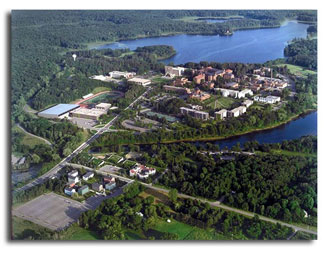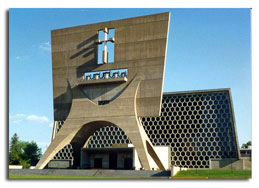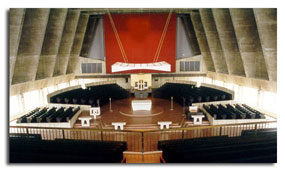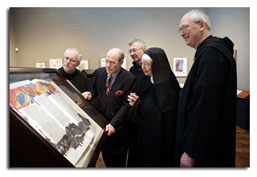
St. John's Abbey & University
in Collegeville, Minnesota
St. John's Abbey in
Collegeville, Minnesota is a Benedictine monastery affiliated
with the American Cassinese Congregation.
The Abbey was established following the arrival in the area
of monks from the Saint Vincent Abbey in Latrobe, Pennsylvania
in 1856. Saint John's is the second-largest Benedictine abbey
in the Western Hemisphere, with 164 professed monks. John Klassen,
OSB, currently serves as abbot.
Monks from the Abbey serve parishes in the Diocese of Saint
Cloud and in the Archdiocese of Saint Paul and Minneapolis.
The Abbey's Hill Museum and Manuscript Library houses the world's
largest collection of manuscript images, and will also house
the St. John's Bible, the first completely handwritten and illuminated
Bible to have been commissioned since the invention of the printing
press.
The community operates The Liturgical Press, St. John's University,
and St. John's Preparatory School, all located on the grounds
of St. John's in Collegeville. The grounds also house the Collegeville
Institute of Cultural and Ecumenical Research, the Episcopal
House of Prayer (Diocese of Minnesota), a Minnesota Public Radio
studio, and the Saint John the Baptist Parish Church. The 2500
acre grounds of the Abbey comprise lakes, prairie, and hardwoods
on rolling glacial moraine, and has been designated as a natural
arboretum.
The Abbey is the location of a number of structures designed
by the modernist architect Marcel Breuer. The Abbey Church with
its banner bell tower is one of his most well-known works. --
From Wikipedia

The
North Facade and Bell Banner of the Abbey Church
THE BELLS - On the vigil of Christmas, 1989 the
present bells were dedicated. These bells replace the original
bells that were
first installed in the former abbey church in 1897 and moved
to this church in 1960. The five bells were produced by Petit & Fritzen
bell foundry in Aarle-Rixtel, Holland and purchased through I.
T. Verdin Company of Cincinnati, Ohio... The largest bell weighs
8,030 pounds while the smallest bell weighs 1,683 pounds... The
bells are dedicated to the Holy Trinity, Blessed Virgin Mary,
Guardian Angels, Saint John the Baptist and Saint Benedict.

The Abbey Church of Saint John the Baptist
The Abbey Church of Saint John the Baptist is the place of worship
for the monastic community of Saint John's Abbey. The monastic
community celebrates the Eucharist and the Liturgy of the Hours
here each day. In addition, the church is the home of Saint John
the Baptist Parish and is the primary place of worship for the
Saint John's University community... The Abbey Church is one
of the masterpieces of architect Marcel Breuer.

The Heritage
Edition is the limited-edition, full-size reproduction of The
Saint John’s Bible. The Heritage Edition presents
an opportunity for select subscribers to personally experience
this extraordinary manuscript. The Saint John’s Bible
Web Site
In the 8th Century, near what are now Scotland
and England, Benedictine monastic scribes created a Bible that
today is one
of the longest surviving monumental manuscripts in the Western
world... Nearly 1,300 years later, renowned calligrapher Donald
Jackson approached the Benedictine monks of Saint John’s
University and Abbey in Collegeville, Minnesota, with his life-long
dream: to create the first handwritten, illuminated bible commissioned
since the invention of the printing press. The Saint John’s
Bible uses ancient materials and techniques to create a contemporary
masterpiece that brings the Word of God to life for the contemporary
world.

A Perfect Script - By The Reverend Christopher Calderhead
Donald Jackson assembled a team of skilled scribes
to write The Saint John’s Bible. They expected to have
an exemplar of the script, a pattern or model they could follow.
But there
was no exemplar. They arrived at the Scriptorium to find a script
in development, a work in flux. This was not just an omission.
There was a method in it.
The calligraphers came together in February 2000
in order to form a working team. This visit has been dubbed ‘the Master
Class’. Everything else was put to one side as Donald and
his scribes studied the script together. The whole process of
writing was examined, tested, pulled apart, and put back together
again. The script would gel along with the group.
“It’s not a question of copying a shape,” Donald
said, “but adopting a shape as your own child—nurturing
it—making it your own. It should be open for the scribes
to do what they’d hoped they’d do with it.”
The challenge he was setting them was enormous. What was this
script he presented to them? It was a complex creation.
Brian Simpson described it. “It was more different from
other scripts than I thought. I looked at it at first and said, ‘Oh,
it’s a rounded italic.’ But it’s not. It is
difficult.” Sue Hufton had a stab at describing it. “It
is not conventional. Not roundhand, italic, or foundational.
I got myself in a muddle early on with these terms. It’s
not even a mixture of these terms. It’s not easily defined.
It’s to do with the movement of the pen. It’s rounded,
but not a wide round. It’s based on an oval rather than
on a circle. The action is similar to round letterforms, and
to cursive, italic, whatever.”
This was a script which challenged the easy classification the
scribes might have been used to. I asked Sally Mae to describe
it: what was the pen angle; what were the proportions?
“It’s not to do with that.” None of the classic
calligrapher’s vocabulary applied. “No pen angle,
no x-height, no exemplars. At the end of the day, I had to throw
all that out the window. You have to trust yourself, and you
have trust DJ.” Sue echoed Sally: “I was presented
with a script that in a funny kind of way made me set aside everything
I knew about letter forms, the relationships between letters—put
to one side all my preconceptions about letterforms. And yet,
this is the thing—I needed every scrap of knowledge and
experience I could draw from.”
The notes for the master class appear alarmingly
casual. A block of eighteen lines of Bible script appears at
the top of the first
page. It is a loose, even casual, version of the script. It is
dotted with small annotations. Below this, enlarged letters and
parts of letters give evidence of a detailed discussion of the
Bible script. These, too, are marked with small checks and xs.
This is not an exemplar. It looks like the kind of thing you
see on a blackboard in school after a long and complicated lecture.
Donald told me he had to stop doing the large demonstration writing;
it altered the motion of the pen, so didn’t reflect the
subtleties of the writing at the smaller scale of the actual
text.
Sue remarked, “I would not have done it this way. This
is what I am required to do. But then it becomes my own.” She
paused for a moment before correcting herself. “No. It
becomes ours.”
The team aspect quickly became important. Sue
said, “When
we go down there, we feel part of a team, even if we haven’t
met all the team members—especially the illuminators. We
refine the script together. Donald doesn’t have any one
set way. You want security of an exemplar. But it’s good
we never had one. The evolution has been allowed to happen.”
Now that they’ve been writing for the better part of two
years, Brian said to me, “Two years in, and we’re
just beginning to understand the script. It feels better, it
looks better.”
Sue agreed. “It amazed me how much we’ve been pushed
to our limits. ”Brian said on their last visit to the Scriptorium, “It
got quite exciting—we laid our pages all out, like a book—we
could see the thing as a whole. It came to life. The weight,
texture, appearance of the script all held together. It was all
from the same book. Personality is important. It does not stifle
personality. It’s a harmony: The individual struggles fade
away.”
When they step back from their work, they can
enjoy what they have made. I asked him about how the ink sat
on the page. “The
ink dries well. It’s almost shiny. You can see that it
stands just proud on the vellum.” He paused for a moment. “It’s
a lovely thing,” he said with a sigh.
|

